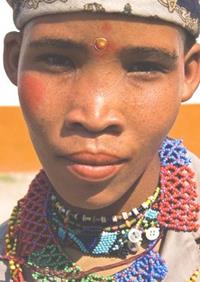
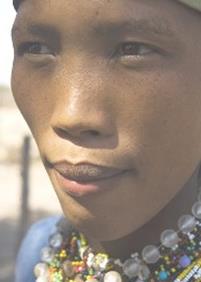
A recent international study undertaken by Shanghai scientists and multinational academics has confirmed that the Chinese did not originate from Peking Man in northern China as was once believed, but from the Black East Afrikans similar to these who migrated via South Asia to China about 100,000 years ago.
Results of the analysis indicate that Southeast Asia was the first destination of the migration from Afrika to Asia which commenced about 100,000 years ago, moving into Southern China before crossing the Yangtze River into Northern China.
No evidence could be found anywhere that was consistent with the hypothesis of any independent origin in China, so these findings have strongly challenged the theory which declared that different groups of humans evolved separately and at the same time in diverse locations around the world.
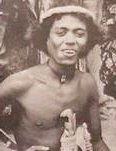

School textbooks in China have been teaching that the Chinese race evolved from Peking Man, but Shanghai scientists and international researchers have dismissed this theory after discovering that early human families evolved in East Afrika about 150,000 years ago.
This revelation is based on the DNA analyses of 100,000 samples collected from around the world, which show that the 65 branches of the Chinese race share similar DNA mutations with the people of East and Southeast Asia and have originated out of Afrika.
Bits of DNA, which are short repeating pieces that provide information about the genetic variation among different people were examined, and this revealed that genetically all Chinese have a lot in common.
Note the Black Chinese people in these photos
This recent study renders null and void the theory that Peking Man was the ancestor of the Chinese people, and also dispels the myth and belief once held by modern Chinese scholars that the Chinese race had descended from the Yellow Emperor and evolved separately from the other races. Skeletal remains in Southern China clearly show that they are indeed Negroid. The people of that era also practiced the Afrikan ritual of single burials.
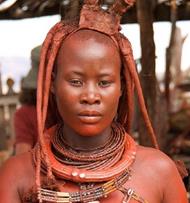

These findings add further weight to the Afrikan view that all human life began in Afrika from one race which was the aboriginal Afrikan people from the tropical regions of Afrika, in particular the Omo region of Ethiopia.
Archaeology, the ancient texts, and forensic tests all confirm that China's first two earliest important dynasties, the Xia and the Shang (Chang) were Black Afrikan with an Australoid type present in smaller percentages. The first Shang king was Xuan Wang which means Black King. Xuan means Black. Another Shang Dynasty King was Xuan Niao meaning Black Hawk. Here is a Himba woman left, from Namibia with mongoloid features.

Professor Jin Li, one of China’s leading geneticists, led a project with an international research team that included Russians, Indians, Brazilians and researchers from other nations, where he set out to prove that the Chinese people evolved independently from everyone else from Homo erectus in China. However, he ended up proving that the modern Chinese actually originated in Afrika, and that modern humans evolved from a single ancestor and not from multiple origins as some experts theorize.
Jin Li’s research was based on DNA tests which have revolutionized the study of human evolution, and supports the global scientific agreement that all modern humans are descendants of the people who left Afrika tens of thousands of years earlier.
Jin Li, a professor at the National Human Genome Centre and Fudan's Institute of Genetics both in Shanghai, stated, “Before the project started, I was hoping that I could identify or could be able to find the evidence that support an independent origin of Chinese in China, because I am Chinese who came from China, and through the educational process, I always believed that there is something special about Chinese.”
Professor Li had singled out a male genetic marker that surfaced only about 80,000 years ago in Afrika, which means that any man who carries this genetic marker must have recent Afrikan ancestors and cannot be a descendant of the more ancient Asian Homo Erectus. Professor Li took about 20,000 DNA samples from over 160 ethnic groups across East Asia, and after careful analysis in his lab, came to the following conclusion. “We did not see even one single individual that could be considered as a descendent of the Homo erectus in China, rather everybody was a descendent of our ancestors from Afrika”.
Jin Li’s research presented evidence affirming that the majority of the gene pools in China originated out of Afrika.
The final results could not have been made any clearer, and when posed with the question, “How did you feel as a Chinese person?” Professor Li responded, “After I saw the evidence generated in my laboratory, I think we should all be happy with that, because, after all, modern humans from different parts of the world are not too different from each other, and we are all very close relatives”.
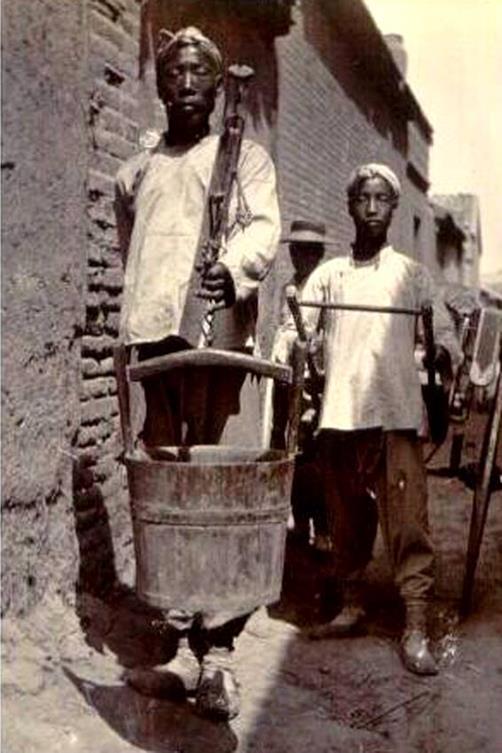 The Black race is therefore the only original race that exists today and all others are simply variations of this original Negritic race. Moreover, the appearance of other races is a recent occurrence in world history which appeared after the migrations of Black people from Afrika into Europe and Asia.
The Black race is therefore the only original race that exists today and all others are simply variations of this original Negritic race. Moreover, the appearance of other races is a recent occurrence in world history which appeared after the migrations of Black people from Afrika into Europe and Asia.
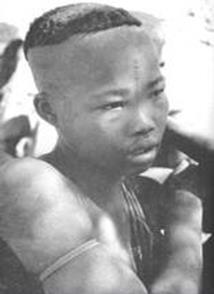
These original, oriental people of China were known in historical literature as Negro, Austroloid or Oceanean by the Europeans, however, not a single shred of evidence concerning the thousands of years of Black occupation in China can be found in any Chinese Museum, except for a few Chinese documents which report that some major kingdoms there were ruled by Blacks until around 1000-700 BC. However, these facts are recorded in the Afrikan, East Indian and some Black-American history books. Here is a Black Chinese boy.
Afrikoid people from Kush in Afrika began entering China and Central Asia via Iran while other groups reached China by sea. These two migration routes taken by Afrikans to China led to the development of the southern Chinese branches of Afrikoids called Yi, li-man Yueh and Man, while the northern Chinese branches of Afrikoids were called Kui-shuang (Kushana) or Yueh-chih. Blacks also lived in Turkestan, Mongolia, Transoxiana, the Ili region and Xinjiang Province, including the Yueh Tribes along the north east coastal region. The Nakhi, (which literally means Black man) of Southern China were originally described as Black people.

THE NAKHI PEOPLE


By the way Afrika has the tallest and shortest people in the world, and the so-called Asian or slanted eye is a trait which came from the Afrikans. This facial type is typical Negritic with eyes that seem to slant, representing a common, racial characteristic generally found in West Afrika, the Sahara, and in South Afrika among the Kung-San Bushmen (right) and other Afrikans.
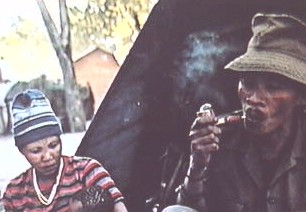

The indigenous inhabitants of Southern Afrika and the Kalahari, whose territory covers most regions including Angola, Mozambique, Zimbabwe, Namibia, Botswana, Swaziland, and Lesotho, are usually referred to as Bushmen, Kung-San, Khwe, Sho, Kung, or Barwa. The Kung-San is one of the most ancient, pure, Afrikan populations on earth, and carries the physical traits that are found among the Mongoloid people.
The features of the Kung-san include Mongoloid eyes, high cheekbones, small stature, very kinky hair and a brown to yellow-brown complexion. However, the Kung-san and other groups in Southern Afrika with similar features have not intermixed with the Asians of any other race, but continue to remain pure Afrikan Blacks.

THE KUNG-SAN PEOPLE
 The earliest occupants of Asia were described as small Black pygmies, and Chinese historians also described the Fou Nanese people of China as small and Black. The Ainus, Japan's oldest known inhabitants traditionally refer to a race of Black dwarfs who inhabited Japan long before they did. The Ainus people originated in Black Egypt and are recorded as having made large migrations to the Asian continent, taking with them thousands of years of Afrikan-Egyptian knowledge and influence. Observe a Black Chinese crouching in the bottom left corner.
The earliest occupants of Asia were described as small Black pygmies, and Chinese historians also described the Fou Nanese people of China as small and Black. The Ainus, Japan's oldest known inhabitants traditionally refer to a race of Black dwarfs who inhabited Japan long before they did. The Ainus people originated in Black Egypt and are recorded as having made large migrations to the Asian continent, taking with them thousands of years of Afrikan-Egyptian knowledge and influence. Observe a Black Chinese crouching in the bottom left corner.
These migrations would explain the existence of man-made pyramids in China and Japan which were built by Afrikans of the Nile Valley, of which the Chinese have no idea as to how they got there. China's pyramids are located near Siang Fu city in the Shensi province. The Japanese pyramids were built during the time of Mu. They were made of stones not indigenous to Japan and are often mistaken for hills because of their eroded appearances.
The first image above was taken in west central China to the north of Yunnan which is Sichuan province, one of the largest provinces in the country. It shows a Black Chinese boy dressed in tattered clothing from the village called So.
The second image which was taken on the streets of Peking around 1869, shows a Black Chinese Mother with her children.
The third photo was taken in Canton and shows a Black Chinese woman sorting leaves during black tea cultivation in the Guangdong province.
 The three major empires or first civilizations of China were [1] The Xia Dynasty (2205-1766 B.C.), [2] The Shang/ Yin Dynasty founded by the Yi tribe headed by King T'ang or Ta, the Afrikan-Mongolian (1600-1046 B.C.), and [3] The Zhou Dynasty which was the first dynasty founded by the Mongoloid people in China called Hua (pronounced Who-aa). King T’ang and the Shang dynasty were responsible for unifying China to form their first civilization (1600-1046 B.C.)
The three major empires or first civilizations of China were [1] The Xia Dynasty (2205-1766 B.C.), [2] The Shang/ Yin Dynasty founded by the Yi tribe headed by King T'ang or Ta, the Afrikan-Mongolian (1600-1046 B.C.), and [3] The Zhou Dynasty which was the first dynasty founded by the Mongoloid people in China called Hua (pronounced Who-aa). King T’ang and the Shang dynasty were responsible for unifying China to form their first civilization (1600-1046 B.C.)
The founders of Xia and Shang came from Afrika via Iran, and according to Professor Shun-sheng Ling, the earliest documented ruler ship of China known as the Xia and Shang dynasties, were governed by emperors called Xuan Di which means Black Emperor, who introduced farming and writing to China. Under their leadership, trade cities and travel developed, and by 3500 B.C., Blacks in China were raising silkworms to manufacture silk. Xuan Di is not a name but a title like Pharaoh.
The fundamental structures of a stylish calligraphy which is still present today was perfected by the Chinese under this Black dynasty, but in addition to writing, the Blacks of the Xia and Shang dynasties introduced bronze working to China and invented the pounded earth architecture associated with early Chinese city-states.
Tang Dynasty 7th century Western Zhou 1100 B.C.
Ancient Afrikans originated in Afrika before spreading out and covering the entire earth.
There was no location called the Middle East. The entire continent of Afrika originally enclosed all the land as far as China down through to India.
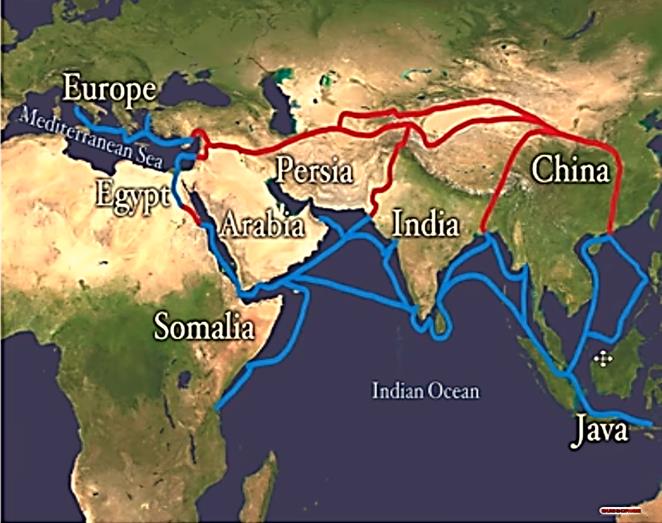
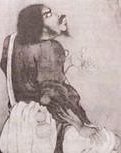
These Afrikans also took the art of fighting or martial arts, which was developed in the Horn of Afrika and known today as Tai Chi, Kung fu, Judo and Tae Kwon Do, into China. This is a picture of Teguai, the Black martial artist from china's golden period around 1000 A.D. The martial arts therefore originated in AFRIKA not Asia, and it was the ancient Kemetics (Black Egyptians) who discovered very early that “the movements of animals could be used effectively to develop their fighting skills”. They also incorporated the concept that "animal principles" could be isolated within the consciousness and manifested into an unconquerable fighting force.

Inside the tomb of Imhotep are stone wall carvings of warrior scientists displaying a number of wrestling holds, kicking, throwing, punching and other fighting techniques. Also inscribed in the Tombs of many Kemetic (Egyptian) Governors who lived 4,200 years ago, are diagrams of more than 500 pairs of wrestlers and other warriors demonstrating weapons usage including the lance and short sticks. This diagram shows a section of the wrestling and martial arts moves that were sketched into an ancient Egyptian tomb wall of Governors at Mahez or Beni Hasan, some 2800 years before the birth of Christ, representing the oldest record of a martial arts system of training in ancient Egypt.
This type of wrestling which is still practiced in Nubia and West Afrika today was copied and practiced by the ancient Greeks. These carvings constitute the ancient records that laid the foundation for the world's first martial arts system. Furthermore, these Black Egyptians had developed an understanding of the vital energy of the soul called chi in Chinese, ki in Japanese and ka in the netjer writing of ancient Kemet.
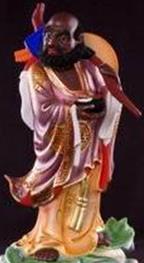
The martial arts practice presently recognized as Chinese started around 500 C.E under the influence of a Black Dravidian and Buddhist Priest from India, named Bodhidharma. Also known as Dharuma in the Japanese archives, Bodhidharma founded Zen Buddhism in China and taught the monks at the Shaolin Temple a set of exercises, movements, and breathing techniques which became known as the Shaolin Ch'uan Fa, Temple Boxing, or the “18 Hands of Lo Han”, which formed the foundation of Chinese Shaolin Kung-Fu and Japanese Karate. Bodhidharma is mostly described as Persian or brahma Indian. This statue stands inside the shaolin temple in china and it represents him as being darker than either a Persian or Indian.
Afrikans on the continent still practice their own ancient martial arts styles, and continued practicing even when enslaved in the Western Hemisphere. This tradition continues to thrive in the Black Brazilian martial arts form called Capoeira. “A Samurai, to be brave, must have a little Black blood".
The Mesakin and Kao Nuba people of Nubia still have a tradition that requires all young men to participate in martial arts training. This Afrikan science of self-defense is called Mon Tu from which the Chinese pronunciation “kung fu” may have originated. In fact, about 4,600 years ago, the Mon Tu was recorded in the 12th century tomb carvings of Prince Amenemhat (Amenyma’at) inside the tombs of Imhotep.
The pharaohs of Ta Meri (Egypt) recorded their interest in athletic activities on the walls of their temples where sports included Mon Tu (martial arts), and consisted of grappling (wrestling holds), stick fighting (weaponry), boxing (punches), acrobatics and other activities. The oldest wrestling scenes dating from 2400 B.C. adorned the tombs of Ptah-hotep and Akhet-hotep.
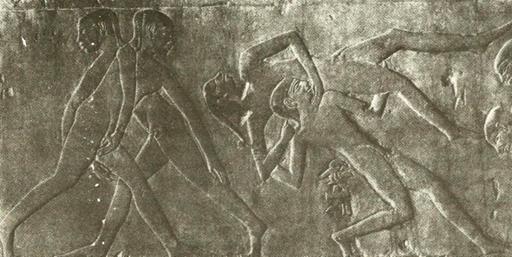
The tomb of Ptahhotep in the 5th dynasty, showing boys wrestling in Egypt.
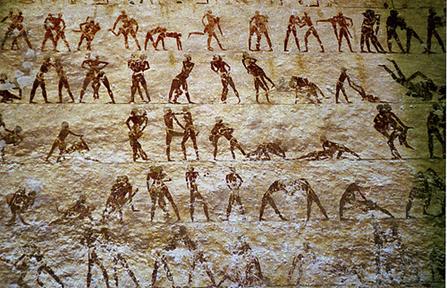
These carvings make up the ancient record of the world’s first martial arts system which originated in Afrika, therefore, it is a general misunderstanding that martial arts had its origin in China, Korea or Japan. At Beni Hasan, more than 4000 wrestling scenes were found, dating back from 2000 B.C. Here is a sketch from the tomb of Prince Khety at Beni Hasan during the 11th dynasty depicting wrestlers. Hieroglyphics found in the temple of Ramses III in Medinet Habu are over 3100 years old, making them much older than the East Asian martial arts which are only 2200 years old. The earliest representation of any kind of belt associated with the martial arts is found in Kemet / Egypt, along the banks of the Nile in tombs belonging to Prince Khety, and Prince Baquet III of the 11th and 12th dynasties, circa 2,800 B.C.

The first Chinese emperor of the pre-dynastic times was the legendary Fu-Hsi (Fu Xi), (Son of Heaven) 2953-2838 B.C. The name Xi is also the same indigenous name of the Olmecs who were the actual builders of the pyramids in China. Fu Xi was a woolly haired Moor (mu’ur or xi) and the father of the Tai Chi philosophy of yin and yang. He was also the originator of the oracle of the I Ching, or The Book of Change dating back to 909 BCE, known to be the oldest most revered system of prophecy that has influenced those eminent philosophers of Chinese medicine and thought. Ancient Chinese medicine dates back to the Shang Dynasty founded by the Afrikan King T'ang around 1500-1000 B.C. The Shang (Chiang) and the Chou dynasties were credited with bringing together the elements of Chinese medical concepts. The Shang was given the name of Nakhi. Na means Black, Khi means man.
Many of the great principles of Chinese medical science compiled during the Shang period were later developed during the Han Dynasty (168 B.C. to 8 A.D.), which began to fuse Shang medical concepts with views from the philosophical ideas of Confucius (551-479 B.C.). In this way, a system was produced which explained all phenomena in relation to the whole, and under this system, everything including the human body and the organs were organized within the system of "Yin" and "Yang" and the "five elements", or what is known as the five phases theory.
Chinese medicine uses the logic of the Ancient Egyptians who viewed the universe as process-oriented where no boundaries between rest and motion, time and space, mind and matter, sickness and health exist. The Chinese looked at reality as a unified field or an interwoven pattern of inseparable links in a circular chain called the Tao, from which all things and events in nature such as the seasons, colour, sound, organs, emotion, climate, matter and energy flowed.
The culture hero Huang Di, whose name was pronounced in old Chinese as Yuhai Huandi or Hu Nak Kunte, shows a link directly out of Afrika. He arrived in China from the west around 2282 B.C., and settled along the banks of the Loh River in Shanxi. This transliteration of Huan Di, to Hu Nak Kunte should be of interest to Black people who may recognise that Kunte is a common clan name among the Manding people. These Afrikans who founded the Chinese civilization were often called Li Min "Black headed people" by the Zhou dynasts, which is similar to the Sumero-Akkadian / Babylonian term Sag- Gig-Ga also meaning "Black headed people". Currently, Blacks are very rare in China today because of the genocide of blending the races, which might have been a tool utilized there and throughout the world to eliminate the Black skin.

This is Bao Zheng – The Black Chinese Lord of Justice who is respected today as the cultural symbol of justice in Greater China.
This is what occurred in Argentina, a nation which had more Blacks than whites during the 1700's, and it also occurred in Mexico and most areas of Latin America, where the Blacks are still severely oppressed. In sections of North Afrika, the Middle East and Southern Europe, the genocide of mixing was successful at eliminating the Black populations from these regions except in India, where the racist caste system preserved the purest of India's original Black Negros. These include the Black Dalit or Untouchables (Negro-Australoids) who were kept segregated and isolated for thousands of years by the Indo-European invaders who migrated from Central Asia/North-Eastern Europe.
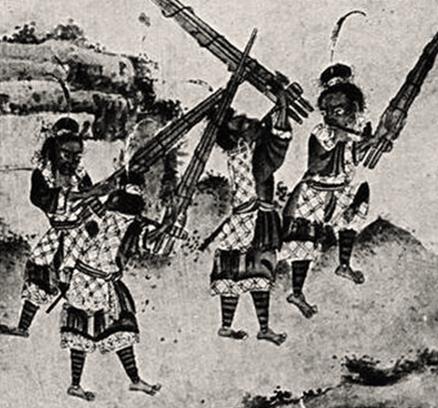
This is an 18th century rendition of the famed Hei Miao tribe when that Black community was still in existence.
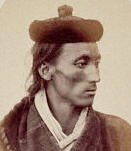
The original or first people of India were also Afrikans, in fact, the Latin word India comes from the Greek word Indus (Indos) which means Black. These Afrikans called Dravidians (Afro-Australoids), many of whom came from Ethiopia, founded the great Indus Valley Civilization around 3000 B.C., bringing many spiritual sciences that originated in Afrika like Yoga, Kundalini and Reflexology with them. Also, being masters of urban planning and architecture, their homes and cities had running water, toilets, and an underground sewage system as seen at the Mohenjo Daro ruins around 2000 B.C. It is also believed that the Ganges, the sacred river of India, was named after an Ethiopian king by that name, who had conquered Asia up to this river. The great King Asoka, Buddha, Krishna, the world's best known Black deities outside of the western world, and other great Black sages emerged from these successive civilizations.
But in the western world nothing is mentioned that “India was once a part of the great Black Ethiopian Empire”, but this can be verified from the pages of the Ethiopian sacred text known as The Kebra Negast which regarded West India as a part of the Ethiopian or Kushite Empire. In biblical times, Afrika included much of what European maps identify as the Middle East, but it was the European mapmakers who determined that regions on the top of Afrika should be divided based on distances from Europe to the Near East, Middle East and Far East. The name Afrika was imposed on this great continent by European explorers who have a bias for renaming and degrading everything they come across.
A replica of an ancient Chinese map which included a recognizable outline of Afrika was made public in November 2002 in South Afrika's Parliament. This Map of the Great Ming Empire Da Ming Hun Yi Tu which dates back to 1389, was created decades before the first European voyages to Afrika. This presented a problem as European scientists could not explain how the Chinese possessed a map that was dated decades before Europeans had sailed to Afrika. The scientists will often come up with some statement like, "Our team of experts are working on that" as the usual response when something surfaces in an area that cannot be linked back to Europe. This is a carefully constructed drawback which suggests that everything documented in history is supposed to be measured to and from Europe which in the scheme of things is only a baby civilization.
YASUKE, THE ONLY BLACK SAMURAI WARRIOR
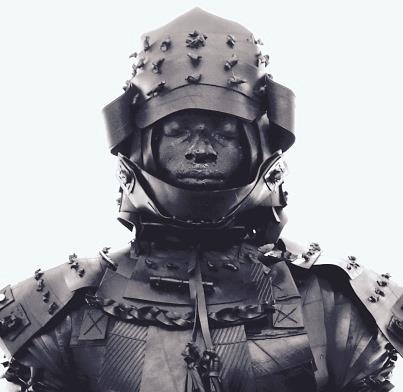 The only Black Samurai ever recorded in written history was the 6ft 2in tall Israelite Moor named Yasuke who was born in 1555.
The only Black Samurai ever recorded in written history was the 6ft 2in tall Israelite Moor named Yasuke who was born in 1555.
The Portuguese were the first Europeans to arrive in Japan, bringing their institution of slavery with them. Afrikans were uprooted from their native lands and sold into slavery on-board Portuguese ships, accompanying their new masters as they travelled across the globe.
Yasuke was taken by force from his homeland, believed to be Mozambique, and sold into slavery to an Italian Jesuit priest named Alessandro Valignano, after the collapse of the Abysinnian kingdom governed by the Ethiopians. In 1579, Alessandro went on a missionary trip to Japan and brought Yasuke with him.
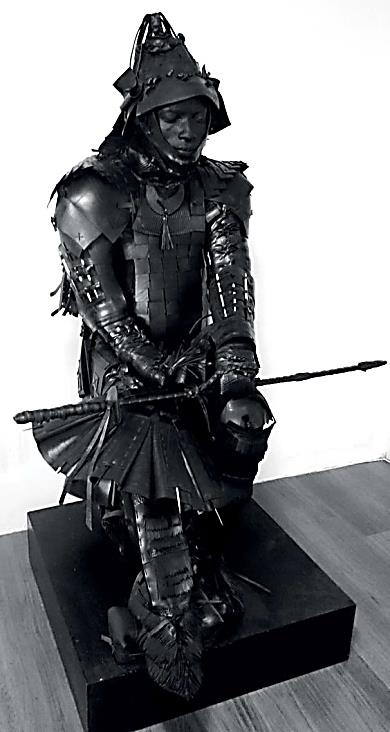 When Alessandro and Yasuke arrived in Japan, the sight of a 6ft 2in tall Black man created a big stir among the locals where the average Japanese man was about 5ft tall. Yasuke’s height would have made him look very imposing to most of the inhabitants. In their excitement to get a look at Yasuke, the door of the Jesuit residence got shattered, leading to a stampede in which a few people were crushed during the commotion. Word of this exotic Black man reached the attention of Japan's Emperor and Warlord Oda Nobunaga.
When Alessandro and Yasuke arrived in Japan, the sight of a 6ft 2in tall Black man created a big stir among the locals where the average Japanese man was about 5ft tall. Yasuke’s height would have made him look very imposing to most of the inhabitants. In their excitement to get a look at Yasuke, the door of the Jesuit residence got shattered, leading to a stampede in which a few people were crushed during the commotion. Word of this exotic Black man reached the attention of Japan's Emperor and Warlord Oda Nobunaga.
When Yasuke was introduced to Oda Nobunaga, he was not only greatly impressed with Yasuke’s towering stature and impressive strength, but also with his Black charcoal skin which he believed was coloured with Black ink. Nobunaga therefore had Yasuke undress from the waist up and had his servants try to scrub the “Black ink” from his skin, but after realizing that Yasuke‘s skin was not painted with ink but was naturally Black, Nobunaga soon took a keen interest in him, describing him as “handsome, healthy” and as someone who had “the strength of 10 men.” This information which described Yasuke was recorded in the “Lord Nobunaga Chronicle,” the principle Japanese source.
Nobunaga brought the former slave into his service, and becoming one of Nobunaga’s right hand men, Yasuke was granted a few coveted benefits which included his own private residence, a sum of money, and also the pleasure of dining with Nobunaga at his table, a rare honour even for a samurai.
Yasuke, the young Afrikan, was hired as the personal bodyguard and first general to the Japanese warlord Oda Nobunaga. In 1581 he was made a samurai, and stationed at one of Nobunaga’s fortresses, the Azuchi Castle. It is believed that when Yasuke came into the Castle, Nobunaga made him a nobleman. He also had had the honour of being assigned as Nobunaga’s sword bearer, an indication of Nobunaga’s high esteem and respect for him. In addition, Yasuke was given a personal ceremonial katana (a traditionally made long Japanese single-edged sword that was used by the samurai of ancient and feudal Japan).
It is noteworthy that in Japan Black people were generally admired rather than discriminated against. Yasuke was therefore not considered as Portuguese human cargo anymore, and in less than a year he was able to rise through the ranks from being a lowly servant to becoming a samurai, attaining a position of the highest respect and recognition among the Japanese elite, a virtually one-off occurrence in history. In other words, this Mozambican slave from far away Afrika had been elevated to the highest echelons of the Japanese warrior class in his new distant home.
Yasuke learnt to speak Japanese fluently, becoming one of Nobunaga’s most trusted advisors who also rode beside him in battle, “an honour reserved only for people Oda must have respected and trusted.”
Yasuke was known for completely disabling his opponents during warfare, and his combat style, expertise, skill and mastery were well documented.
Oda Nobunaga’s exploits suddenly came to an end in June 1582 when he was betrayed by one of his closest generals, Akechi Mitsuhide.
Yasuke fought bravely during the final battle, faithfully defending his master’s castle from Mitsuhide’s forces, continuing to fight even after everything was lost, until he finally surrendered his sword to Akechi. However, since Yasuke was not Japanese, he was spared death and sent back to the “Temple of the Southern Barbarians,” the Japanese reference to the Jesuit church, where he supposedly spent the rest of his days after making his mark on history’s pages.

© John Moore - Barbados, W.I. (March 2000) ©. All rights reserved.